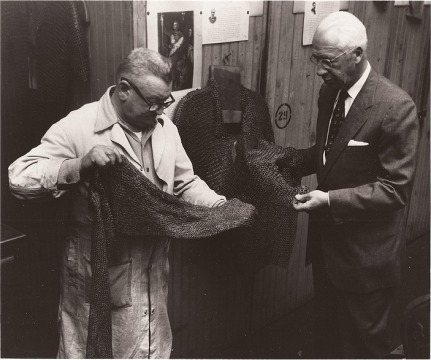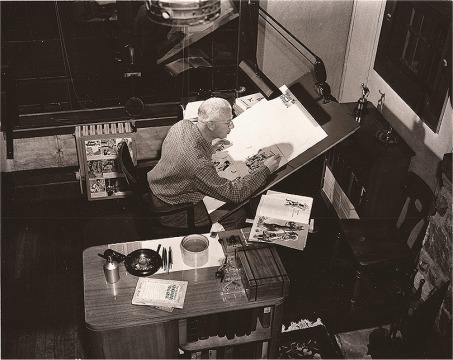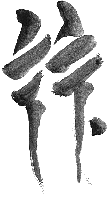CANADIAN
COMIC BOOK HALL OF FAME
THE JOE SHUSTER AWARD
Hal Foster (1892-1982)
Inducted into the Hall of Fame
in 2005
Biography compiled by Phil Latter
Hal Foster, born Harold Rudolf Foster, was born in Halifax,
Nova Scotia, Canada on August 16, 1892. By the age of 8, he already had
the sea in his blood, and he rowed a twelve foot plank (more often, misquote
d as a raft) across Halifax harbour. This is folklore often quoted in local
Halifax comics circles. Two years later, Foster was at the helm of a 30
foot schooner on the Atlantic Ocean. He was but 4 years old when his father
passed on; his mother married once again eight years later. His stepfather
shared his joy of the outdoors in the forests that surrounded Halifax in
those days, and they often fished together. By 1906, the family business
went under and the family moved to Winnipeg. Hal Foster’s last completed
year of grade school was grade 9 (age 13).
At the Winnipeg Carnegie Library, Hal studied anatomy,
later becoming a staff artist at The Hudson’s Bay Company. His role there
was illustrating women’s lingerie, back then, the type plumed with lots
of buttons, lace and fasteners, for their catalogue. Prior to World War
Two, an economic depression set in, and Foster was forced to freelance
out his artistic skills. He married Helen Wells in 1915 who he met that
same year. They worked as hunting guides in Ontario and Manitoba. In 1917,
they founded a claim in the Lake Rice area and commenced prospecting for
gold. This they did for three years until such time as claim jumpers stole
it out from under them, forcing them off the land. Hal Foster made a firm
decision at this time to embark full-time upon a career as an artist. Talking
a friend into a bold plan, they jointly set out together on bicycles on
a 1,000 mile pilgrimage from Winnipeg to Chicago! They arrived in a record
14 days in 1919.
Foster became employed with the Jaln & Ollier Engraving
Company, and he attended evening classes at the Chicago Art Institute.
Later, he attended both the National Academy of Design and the Chicago
Academy of Fine Arts. Following this, he worked for the Palenske-Young
Studio doing ads in addition to covers of magazines. These included the
Northwest Paper, Southern Pacific Railroad, and the Illinois Pacific Railroad,
to name just a few.
Hal Foster was the very first artist to illustrate the
Edgar Rice Burroughs’ Tarzan newspaper strip, which commenced on Jan.7,
1929. He did approximately 300 of these before his return to advertising.
This is where Foster’s well-known nom-de-plume of “The Father of The Adventure
Strip” originated. Hal Foster is credited as being the originator of text
accompanying comic strip illustrations, in place of word balloons, leaving
his well-delineated illustrations uncluttered by captions and text. This
became Foster’s hallmark.
During the Depression of the 1930’s, Hal Foster found
it increasingly difficult to make a living in advertising; work was drying
up in this field as a result. He was therefore persuaded by an agent of
Edgar Rice Burroughs, to return to Tarzan, this time to the weekly Sunday
page. In 1937, Foster went to The United Features Syndicate, with his well-structured
Derek, Son of Thane newspaper strip concept, with hundreds of conceptual
drawings and notes. The title was later changed to Prince Arn, and then,
later, to Prince Valiant. United Features Syndicate, however, turned the
feature down! Foster then took it directly to the world-renowned tycoon
newspaper magnate William Randolph Hearst. “Prince Valiant in The Days
of King Arthur” first saw print on Feb.13, 1937. Additionally, Hal Foster
illustrated the book The Young Knight (1945), and earlier,
in 1943, had adapted the book The Song of Bernadette, in
illustrated form.
Awards won by Foster: the Banshees’ “Silver Lady” award,
in 1952; both the National Cartoonist Society’s “Reuben” in 1957, and later
the “Gold Key” award in 1977. At the age of 73, Foster was inducted into
membership in England’s Society of Arts. In total, Hal Foster produced
1,764 Prince Valiant pages over his career! The last page created solely
by Foster appeared on May 16 of 1971. Thereafter, he chose John Cullen
Murphy from a group of other highly-qualified, well known professionals,
to carry on the strip. However, Foster continued to do layouts, write and
colour the strip for an additional nine years, until Feb 10 of 1980. Hal
Foster passed away on Jul.25, 1982, just three weeks before his 90th birthday.
Shuster Hall Of Fame
Hal Foster Acceptance Speech
Delivered posthumously
by Dave Sim
(April 2005)
I can safely say that I have never felt so gratified,
so humbled, and so intimidated -- simultaneously -- as when author of Hal
Foster: Prince Of Illustrators, Father Of The Adventure Strip, Mr. Brian
M. Kane of Columbus, Ohio left me a phone message saying that the Foster
family had asked that I accept this posthumously awarded Shuster Hall Of
Fame plaque on their behalf.
From the time he bagan work on the Tarzan newspaper
strip in 1929 to when he retrired from his beloved Sunday page landmark,
Prince
Valiant in 1971, Hal Foster has been universally hailed in our field
as one of the tripartite deans of cartoon realism alongside Alex Raymond
of Flash Gordon and Rip Kirby and Milt Caniff of Terry & The Pirates
and Steve Canyon. Each generation of comic strip -- and later comic book
-- artists have credited Hal Foster with being a primary influence on their
own works.
In the comic book field, among the first generation of
illustrators, such diverse talents as Joe Shuster, the late Will Eisner,
Lou Fine, Sheldon Moldoff, and Jack Kirby; among the second generation,
Frank Frazetta -- who even adapted elements of Foster's signature calligraphy
as his own -- Wallace Wood, Al Williamson, Angelo Torres, and Murphy Anderson;
among the third generation, Bernie Wrightson, Barry Windsor-Smith, Michael
Kaluta and Jeff Jones all owed a large -- and wholly credited -- debt to
the works of Hal Foster. As a member of the fourth generation to
be influenced by him -- standing here before you today -- I feel like a
Shapespearean actor imexplicably promoted -- however temporarily -- from
metaphorical spear-carrier to metaphysical knighthood.
I'm tempted to just read aloud the full text of Mr Kane's
definitive biography published by Vanguard Press of Lebanon, New Jersey
in 2001, and see how long it would take before someone cuts me off -- to
read to you of Hal Foster's birth in Halifax on August 16, 1892, of how
the family relocated to Winnipeg in 1905, of Foster's many adventures in
the Canadian wilderness and along the Red River as a lifelong enthusiast
of canoeing and hunting, of his abbreviated boxing career, of his self-education
at Winnipeg's Carnegie Library and of how, in 1920, Foster secured a job
with the Hudson Bay Company as a staff clerk earning $17.50 a week and
where he was later hired to draw sketches of women's intimate apparel.
"I put my whole soul into the work," he said later, more than slightly
tongue-in-cheek. "I don't know when I'd been more interested." He
worked variously in Winnipeg at commercial art studios like Beigden's Limited,
the Commercial Art Company, and the Buckley Studio.
It was the threat of Depression-era starvation more than
anything else that brought Hal Foster to the newspaper strip. Originally
he hadn't been interested in illustrating Tarzan past the 10-week adaptation
of Edgar Rice Burroughs' first novel, feeling that he would be prostituting
his talent in doing so. He would later say, "I was a bit offended to
be asked to sell my birthright for the mess of pottage. But I thought,
'wouldn't it be nice if I had a little bit of pottage right now?'"
Initially, Foster had been content just to churn out the pages, but then
letters started coming in. "I suddenly realised the comics page gave
pleasure to millions," he said, "and changed my attitude about just
scratching out the artwork." He noted that his wife, Helen, helped
him control his inflated ego. So did the miserly page rates, which caused
him to choose to create his own feature in 1937, a feature he would continue
for thirty-four years and nearly two thousand pages, the legendary (in
every sense of the term) Prince Valiant In The Days Of King Arthur.
As I wrote in my own tribute which was edited out of the
manuscript of Mr Kane's book -- there were just too many high-powered names
with greater-seniority -- in parodying a number of comic strip and comic
book artist styles in the pages of Cerebus, I always found it easy enough
to decipher and exaggerate their little drawing tricks and inking idiosyncrasies.
That worked fine until I introduced a Prince Valiant parody, Lord Sliverspoon,
into the storyline. I soon discovered -- as so many before me had discovered
-- that there were no tricks or obscurant idiosyncrasies to the work of
Hal Foster. It was all pure drawing knowledge, an encyclopedic knowledge
of anatomy, dapery, light, shadow, composition line weight and texture,
and the precise interaction of all those elements on the finished page.
As his long-time letterer, Charles F. Armstrong wrote of Foster's determination
to enter into a formal program of study when he was already a successful
commercial illustrator: "It meant his giving up vacations, nights, Saturdays,
and holidays to the drawing and observation of bones, muscles, and nerves.
And believe me, this is work that is tedious, boring, and time-sonsuming.
I know -- having studied under the same anatomy fanatic, Charles Schroeder."
Having already exceeded the universally agreed-upon limits
of the duration of an acceptance speech -- an exceptional circumstance
which I hope you will forgive in light of the accomplishments and wide-ranging
influence of the award recipient -- I'll conclude now by reiterating how
pleased and delighted, humbled, and intimidated I am to accept this award
on behalf of the Prince of Illustrators, the Father of the Adventure Strip,
and the greatest native-born Canadian ever to devote his life to bringing
the highest and most exacting standards of illustrative realism to the
comics page, Harold Rudolf Foster.
Thank you.
~ Dave Sim





